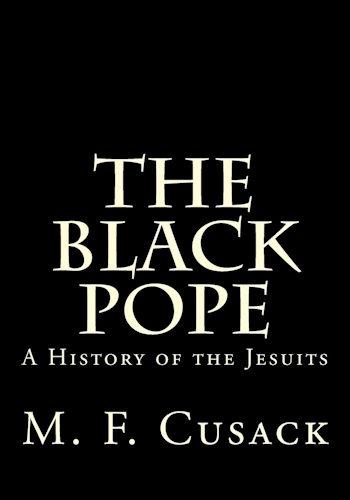

The Black Pope: A History of the Jesuits

This book has stood the test of time, and remains a favorite for students of Church history. "Today the Jesuit is to all intents and purposes master of the situation. His favorite pupils decide Protestant causes, and with calm effrontery honor the head of their Church as a temporal prince" - page 15
Paperback: 214 pages
Publisher: CreateSpace Independent Publishing Platform (February 11, 2014)
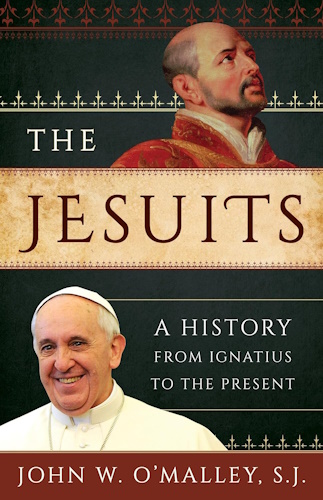

The Jesuits: A History from Ignatius to the Present

This book provides readers with an accessible and concise history of the Jesuit religious order. O’Malley seeks to remove the mystery surrounding the Jesuits by making a complex and difficult history approachable and comprehensible for general readers. Often misunderstood and feared throughout history, the Jesuits have had an important religious and educational role spanning centuries and cultures. Accordingly, the author describes the impact Jesuits have had both inside and outside the Roman Catholic Church. As educators, missionaries, and scholars, the Jesuits have sought to reach every aspect of society. Though concise in his recounting, O’Malley covers every aspect of Jesuit history, from the order's founding to the modern age. Quality and depth are not sacrificed for brevity, never leaving one feeling as if something were missing. For those wishing to know more about the subject, O’Malley includes a helpful bibliography for further reading. This work is a clear, easy-to-read text appropriate for both students and general readers. Summing Up: Highly recommended. All readers. (CHOICE)
Perhaps no organization within the Catholic Church has been both reviled and admired as much as the Society of Jesus, whose members are known as Jesuits. O’Malley (What Happened at Vatican II), a Jesuit priest and professor of theology at Georgetown University, is a masterful historical scholar and he knows how to tell a lively story. He divides the history into four periods, including the founding of the order; its early years; its suppression, when it was disbanded for over 70 years; and the modern and postmodern eras. The founding of Jesuit schools is an especially fascinating topic, as the establishment of educational institutions was not an original intention of Society founder Ignatius Loyola. Yet it is now what Jesuits are primarily known for worldwide. Another intriguing historical episode is the Chinese rites controversy, which pitted the Jesuits against the Dominicans in a battle over missionary tactics abroad. The Jesuits certainly made their share of enemies over the past five centuries, some of whom tried to wipe the organization out of existence. O’Malley’s book would make an excellent introductory text for anyone interested in the history of the Society of Jesus, the Catholic religious order that nurtured Pope Francis I and thousands of other great men. (Publishers Weekly)
With the first-ever election of a Jesuit as pope, this most controversial of Roman Catholic orders has once again arrived center stage. Since Ignatius Loyola instituted the Society of Jesus in the sixteenth century, the Jesuits have provoked both awe and anger from both church hierarchy and secular governments. Ostensibly dedicated to the pope, the Jesuits have found themselves alternately embraced and banned by Rome. Some kings tossed Jesuits into prison and purged them from their realms, while others, notably Russia’s Catherine the Great, embraced them. Himself a member of the order, O’Malley emphasizes the Jesuits’ commitment to education as central to their long-term success. They started schools and universities throughout their mission fields, often inaugurating Western-style higher education in countries such as India, China, and Japan. (Booklist)
O'Malley has once again written a lively and accessible historical introduction to the Society of Jesus. This slight volume serves to whet the appetite, highlighting the general arc of the organization from its founding to today. . . .This is a timely and . . . approachable introduction, especially given the election of the first Jesuit to be elected Pope. (Library Journal)
Professor O’Malley must be lauded for writing such a compelling, comprehensive book. It deserves a place in public and university libraries in Lutheran countries. (Center for Research on Geopolitics)
This volume is a must-have for libraries of all types. O’Malley’s achievement will be the new standard introduction for all audiences, particularly casual readers, seeking a gateway into the extraordinary and still-evolving legacy of the Jesuits. (Catholic Library World)
When Pope Francis was elected in 2013, the world witnessed an event of considerable importance for the Roman Catholic Church. Jorge Mario Bergoglio, a Jesuit, will forever be known as 'the first Jesuit pope in history!' Who better to tell their story, expelling the stigma of a tainted reputation, than a fellow Jesuit priest, John W. O’Malley? Currently a professor of theology at Georgetown University specializing in European church history, he has written several books with his The First Jesuits winning the Philip Schaff Prize for church history. Written for a popular audience, The Jesuits dispels the mystique and enlightens readers concerning the Society of Jesus. . . .Even though the book is clearly a synopsis of the order’s history, O’Malley provides a valuable section following the epilogue for further reading targeting those who wish to study the subject more closely and in depth. This book would be a good choice for readers seeking to gain a cursory understanding of the Jesuits. (The Christian Century)
There is no one else in the world better suited to write a new history of the Jesuits than John W. O'Malley, S.J., the dean of Jesuit historians. For too long readers have lacked an accessible and comprehensive history of the Society of Jesus, and his wonderful book is well worth the wait. Highly, highly, highly recommended. (James Martin SJ, author of The Jesuit Guide to (Almost) Everything)
The history of the Jesuits is so vast and complicated that any generalization about the is bound to be false. Yet a sure guide through the tangled particulars is the great Renaissance scholar John O'Malley. (Garry Wills, author of Lincoln at Gettysburg)
Only John W. O'Malley is today in a position to offer a sweeping scholarly yet accessible overview of the extraordinarily rich and complex history of the Society of Jesus—from Ignatius of Loyola to Pope Francis. (Robert A. Maryks, Boston College, Editor-in-Chief of the Journal of Jesuit Studies)
About the Author
John W. O’Malley, SJ, is a Roman Catholic priest and professor in the department of theology at Georgetown University. He is the author of a number of books, including A History of the Popes, The First Jesuits, and What Happened at Vatican II. He holds the Johannes Quasten Medal from The Catholic University of America for distinguished achievement in religious studies, and he has won numerous other awards, including best book and lifetime achievement. He is past president of the American Catholic Historical Association and the Renaissance Society of America.
Hardcover: 160 pages
Publisher: Rowman & Littlefield Publishers (October 16, 2014)
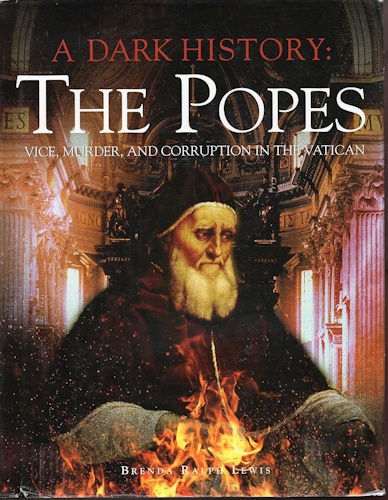

A Dark History: the Popes: Vice, Murder, and Corruption in the Vatican

This book reveals a catalog of wrongdoings perpetrated by popes over the centuries, a record that has been mainly kept from the public eye.
Hardcover: ? pages
Publisher: Metro Books (2011)


The Vatican Exposed: Money, Murder, and the Mafia

Over 50 billion dollars in securities. Gold reserves that exceed those of industrialized nations. Real estate holdings that equal the total area of many countries. Opulent palaces containing the world's greatest art treasures. These are some of the riches of the Roman Catholic Church. Yet in 1929 the Vatican was destitute. Pope Pius XI, living in a damaged, leaky, pigeon-infested Lateran Palace, could hear rats scurrying through the walls, and he worried about how he would pay for even basic repairs to unclog the overburdened sewer lines and update the antiquated heating system. How did the Church manage in less than seventy-five years such an incredible reversal of fortune? The story here told by Church historian Paul L. Williams is intriguing, shocking, and outrageous.
The turnaround began on February 11, 1929, with the signing of the Lateran Treaty between the Vatican and fascist leader Benito Mussolini. Through this deal Mussolini gained the support of the staunchly Catholic Italian populace, who at the time followed the lead of the Church. In return, the Church received, among other benefits, a payment of $90 million, sovereign status for the Vatican, tax-free property rights, and guaranteed salaries for all priests throughout the country from the Italian government. With the stroke of a pen the pope had solved the Vatican's budgetary woes practically overnight, yet he also put a great religious institution in league with some of the darkest forces of the 20th century.
Based on his years of experience as a consultant for the FBI, Williams produces explosive and never-before published evidence of the Church's morally questionable financial dealings with sinister organizations over seven decades through today. He examines the means by which the Vatican accrued enormous wealth during the Great Depression by investing in Mussolini's government, the connection between Nazi gold and the Vatican Bank, the vast range of Church holdings in the postwar boom period, Paul VI's appointment of Mafia chieftain Michele Sindona as the Vatican banker, a billion-dollar counterfeit stock fraud uncovered by Interpol and the FBI, the "Ambrosiano Affair" called "the greatest financial scandal of the 20th Century" by the New York Times, the mysterious death of John Paul I, profits from an international drug ring operating out of Gdansk, Poland, and revelations about current dealings.
For both Catholics and non-Catholics this troubling expose of corruption in one of the most revered religious institutions in the world will serve as an urgent call for reform.
Hardcover: 264 pages
Publisher: Prometheus Books (May 1, 2003)
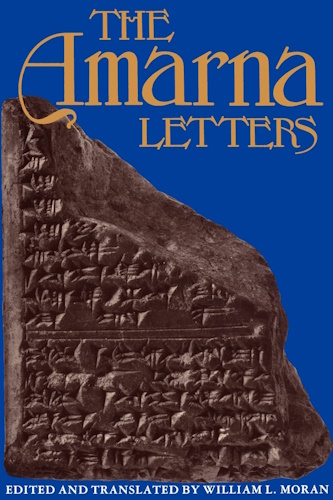

An ancient inscription identified some of the ruins at el Amarna as "The Place of the Letters of the Pharaoh." Discovered there, circa 1887, were nearly four hundred cuneiform tablets containing correspondence of the Egyptian court with rulers of neighboring states in the mid-fourteenth century B.C. Previous translations of these letters were both incomplete and reflected an imperfect understanding of the Babylonian dialects in which they were written. William Moran devoted a lifetime of study to the Amarna letters to prepare this authoritative English translation. The letters provide a vivid record of high-level diplomatic exchanges that, by modern standards, are often less than diplomatic. An Assyrian ruler complains that the Egyptian king's latest gift of gold was not even sufficient to pay the cost of the messengers who brought it. The king of Babylon refuses to give his daughter in marriage to the pharaoh without first having proof that the king's sister―already one of the pharaoh's many wives―is still alive and well. The king of Karaduniyash complains that the Egyptian court has "detained" his messenger―for the past six years. And Egyptian vassal Rib-Hadda, writing from the besieged port of Byblos, repeatedly demands military assistance for his city or, failing that, an Egyptian ship to permit his own escape.
Paperback: 448 pages
Publisher: Johns Hopkins University Press (October 31, 2000)
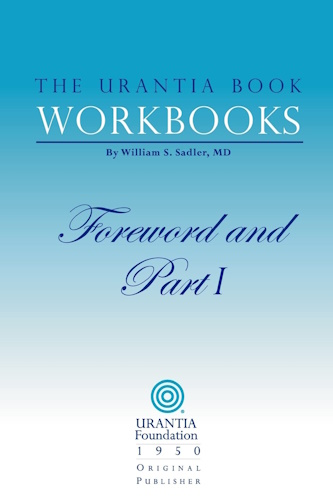

<
The Urantia Book Workbooks: Volume I - Foreword and Part I

Originally published in the 1950s and 1960s, these study aids were authored by Dr. William S. Sadler and Alvin Kulieke to serve as texts to train teachers and students of the Fifth Epochal Revelation. The first of the 2003 re-printings of these texts, used by some of the founding members of the Urantia movement, will be available in May of 2003, with three more volumes to follow in early Fall. These new 6" x 9" paperback books, printed on top-quality paper, feature full-color covers and are thematically organized with discussions on Part I of The Urantia Book, comparisons between the New Testament and The Urantia Book, discussions of the science of The Urantia Book, and many other subjects. These volumes will certainly be a great help to students seeking a greater understanding of this profound gift to mankind.
Series: Urantia Book Workbooks
Paperback: 444 pages
Publisher: Urantia Foundation (May 1, 2003)


The Urantia Book Workbooks: Volume II - Science

Originally published in the 1950s and 1960s, these study aids were authored by Dr. William S. Sadler and Alvin Kulieke to serve as texts to train teachers and students of the Fifth Epochal Revelation. The first of the 2003 re-printings of these texts, used by some of the founding members of the Urantia movement, will be available in May of 2003, with three more volumes to follow in early Fall. These new 6" x 9" paperback books, printed on top-quality paper, feature full-color covers and are thematically organized with discussions on Part I of The Urantia Book, comparisons between the New Testament and The Urantia Book, discussions of the science of The Urantia Book, and many other subjects. These volumes will certainly be a great help to students seeking a greater understanding of this profound gift to mankind.
Series: Urantia Book Workbooks
Paperback: 412 pages
Publisher: Urantia Foundation (May 1, 2003)
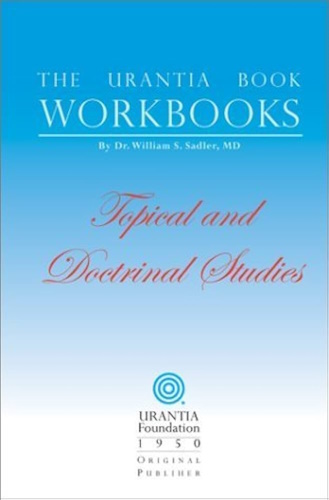

The Urantia Book Workbooks: Volume III - Topical Study

Originally published in the 1950s and 1960s, these study aids were authored by Dr. William S. Sadler and Alvin Kulieke to serve as texts to train teachers and students of the Fifth Epochal Revelation. The first of the 2003 re-printings of these texts, used by some of the founding members of the Urantia movement, will be available in May of 2003, with three more volumes to follow in early Fall. These new 6" x 9" paperback books, printed on top-quality paper, feature full-color covers and are thematically organized with discussions on Part I of The Urantia Book, comparisons between the New Testament and The Urantia Book, discussions of the science of The Urantia Book, and many other subjects. These volumes will certainly be a great help to students seeking a greater understanding of this profound gift to mankind.
Series: Urantia Book Workbooks
Paperback: 620 pages
Publisher: Urantia Foundation (May 1, 2003)


The Urantia Book Workbooks: Volume IV - Jesus

Originally published in the 1950s and 1960s, these study aids were authored by Dr. William S. Sadler and Alvin Kulieke to serve as texts to train teachers and students of the Fifth Epochal Revelation. The first of the 2003 re-printings of these texts, used by some of the founding members of the Urantia movement, will be available in May of 2003, with three more volumes to follow in early Fall. These new 6" x 9" paperback books, printed on top-quality paper, feature full-color covers and are thematically organized with discussions on Part I of The Urantia Book, comparisons between the New Testament and The Urantia Book, discussions of the science of The Urantia Book, and many other subjects. These volumes will certainly be a great help to students seeking a greater understanding of this profound gift to mankind.
Series: Urantia Book Workbooks
Paperback: 456 pages
Publisher: Urantia Foundation (May 1, 2003)
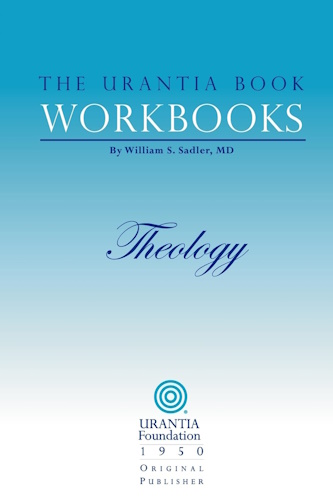

The Urantia Book Workbooks: Volume 5 - Theology

Originally published in the 1950s and 1960s, these study aids were authored by Dr. William S. Sadler to serve as texts to train teachers and students of the Fifth Epochal Revelation. These new 6" x 9" paperback books, printed on top-quality paper, feature full-color covers and are thematically organized. These volumes will certainly be a great help to students seeking a greater understanding of this profound gift to mankind.
Series: Urantia Book Workbooks
Paperback: 640 pages
Publisher: Urantia Foundation (May 1, 2003)
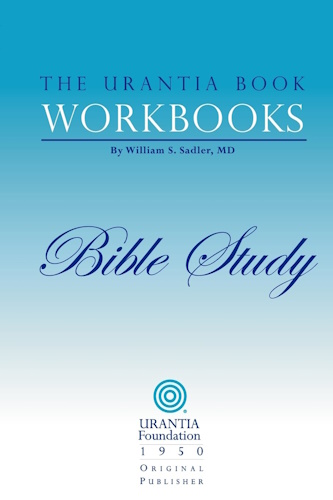

The Urantia Book Workbooks: Volume 6 - Bible Study

Originally published in the 1950s and 1960s, these study aids were authored by Dr. William S. Sadler to serve as texts to train teachers and students of the Fifth Epochal Revelation. These new 6" x 9" paperback books, printed on top-quality paper, feature full-color covers and are thematically organized. These volumes will certainly be a great help to students seeking a greater understanding of this profound gift to mankind.
Series: Urantia Book Workbooks
Paperback: 504 pages
Publisher: Urantia Foundation (May 1, 2003)


The Urantia Book Workbooks: Volume 7 - Terminology

Originally published in the 1950s and 1960s, these study aids were authored by Dr. William S. Sadler to serve as texts to train teachers and students of the Fifth Epochal Revelation. These new 6" x 9" paperback books, printed on top-quality paper, feature full-color covers and are thematically organized. These volumes will certainly be a great help to students seeking a greater understanding of this profound gift to mankind.
Series: Urantia Book Workbooks
Paperback: 216 pages
Publisher: Urantia Foundation; 7 edition (October 1, 2003)


The Urantia Book Workbooks: Volume 8 - Worship and Wisdom

Originally published in the 1950s and 1960s, these study aids were authored by Dr. William S. Sadler to serve as texts to train teachers and students of the Fifth Epochal Revelation. These new 6" x 9" paperback books, printed on top-quality paper, feature full-color covers and are thematically organized. These volumes will certainly be a great help to students seeking a greater understanding of this profound gift to mankind.
Series: Urantia Book Workbooks
Paperback: 236 pages
Publisher: Urantia Foundation (October 1, 2003)


Wholeness and the Implicate Order (Volume 135)

David Bohm was one of the foremost scientific thinkers and philosophers of our time. Although deeply influenced by Einstein, he was also, more unusually for a scientist, inspired by mysticism. Indeed, in the 1970s and 1980s he made contact with both J. Krishnamurti and the Dalai Lama whose teachings helped shape his work. In both science and philosophy, Bohm's main concern was with understanding the nature of reality in general and of consciousness in particular. In this classic work he develops a theory of quantum physics which treats the totality of existence as an unbroken whole. Writing clearly and without technical jargon, he makes complex ideas accessible to anyone interested in the nature of reality.
About the Author
David Bohm (1917-92). Renowned physicist and theorist who was one of the most original thinkers of the second half of the twentieth century.
Paperback: 284 pages
Publisher: Routledge; 1 edition (November 17, 2002)
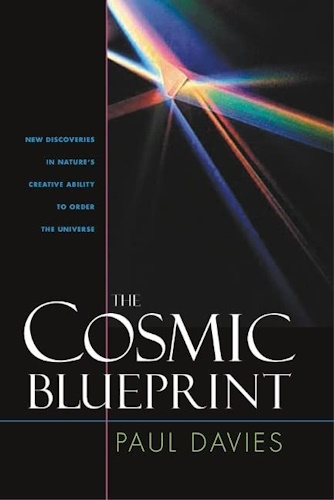

The Cosmic Blueprint: New Discoveries In Natures Ability To Order Universe

In this critically acclaimed book, first published in 1988 and now reprinted in paperback, scientist and author Paul Davies explains how recent scientific advances are transforming our understanding of the emergence of complexity and organization in the universe.
Melding a variety of ideas and disciplines from biology, fundamental physics, computer science, mathematics, genetics, and neurology, Davies presents his provocative theory on the source of the universe's creative potency. He explores the new paradigm (replacing the centuries-old Newtonian view of the universe) that recognizes the collective and holistic properties of physical systems and the power of self-organization. He casts the laws in physics in the role of a "blueprint," embodying a grand cosmic scheme that progressively unfolds as the universe develops.
Challenging the viewpoint that the physical universe is a meaningless collection particles, he finds overwhelming evidence for an underlying purpose: "Science may explain all the processes whereby the universe evolves its own destiny, but that still leaves room for there to be a meaning behind existence."
About the Author
Paul Davies is professor of natural philosophy in the Australian Centre for Astrobiology at Macquarie University. His research has spanned the fields of cosmology, gravitation, and quantum field theory, with particular emphasis on black holes and the origin of the universe. He is currently working on the problem of the origin of life and the search for life on Mars. He is a well-known author, broadcaster, and public lecturer and has written over twenty-five books. Among his better-known works are God and the New Physics, The Mind of God, About Time, The Fifth Miracle, and How to Build a Time Machine. In recognition of his work as an author, he was elected as fellow of The Royal Society of Literature in 1999.
His contributions to science have been recognized by numerous awards, including the 2002 Michael Faraday Prize by the Royal Society and the 2001 Kelvin Medal and Prize from the U.K. Institute of Physics. In April 1999 the asteroid 1992 OG was officially named (6870) Pauldavies in his honor. His most significant award was the 1995 Templeton Prize for Progress in Religion, the world’s largest prize for intellectual endeavor.
Paperback: 232 pages
Publisher: Templeton Press (April 28, 2004)
![]()
![]()